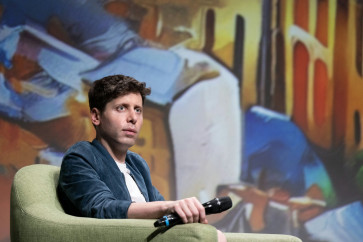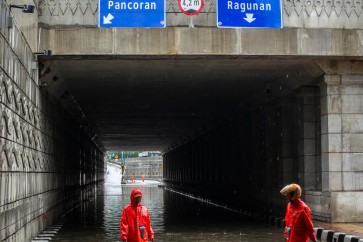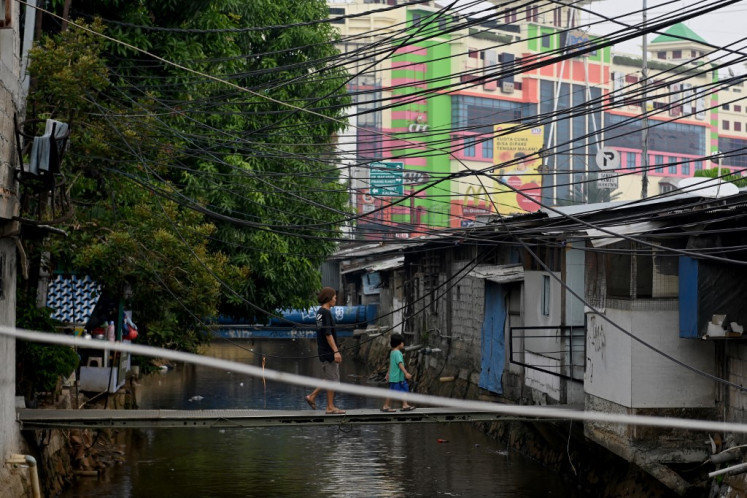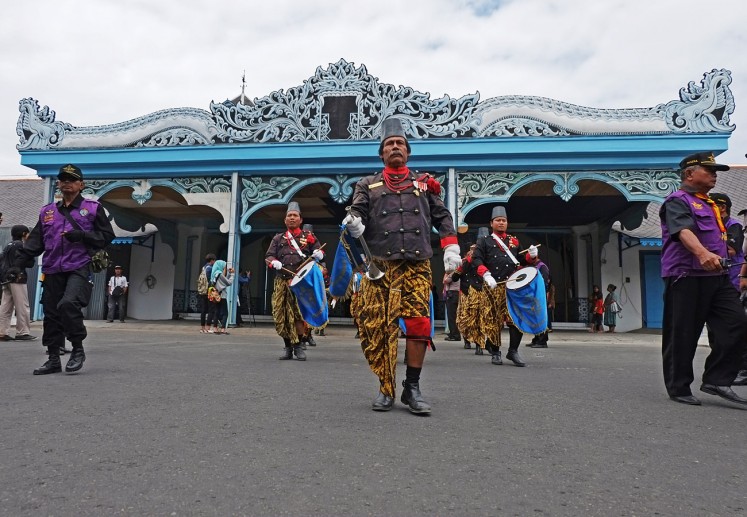Jamming the Jogja way
Ade Gunawan’s Upeti or Bribery at Sangkring Art Space
Change text size
Gift Premium Articles
to Anyone

Ade Gunawan’s Upeti or Bribery at Sangkring Art Space. JP/Munarsih Sahana
“Jogja Jamming — Art Archive Movement” is the theme of the month long Yogyakarta visual arts biennale 2009 currently underway, aimed at encouraging collaboration among local artists, and between artists and the local community.
Jamming, as in a musical jam session, means working together to create a more interesting outcome, while the parties involved feel content and not pressured to work together, says Butet Kartaredjasa, director of the Biennale Jogja X – 2009.
“This year, the organizer started documenting the art event for the future development of the art scene in the city, since we are planning to make Jogja the capital of Indonesian arts,” he said.
A permanent board with support from the local government, which is responsible for the sustainability of the biennale, is expected to be established soon. According to Butet, parties and companies previously shied away from giving sponsorships when they found out there was no such institution.
They also plan to choose a team of curators for the next biennale at the end of the current event, with the hope that the team will have plenty of time to prepare the next biennale.
Over the next few days, visitors to Yogyakarta will feel the pulse of the art biennale as they take in various installations and sculptures on display in public spaces citywide. Many art programs, including performances and public lectures, will also be held.
This is also in line with the adoption of the spirit of local values from Javanese proverbs, such as Seni Agawe Santosa, a twist on Rukun Agawe Santosa, which means working together or standing united to be stronger in order to create a better outcome. They also use several other local sayings, such as gugur gunung or volunteering.
This local wisdom, Butet says, matches the spirit of jamming highlighted in this year’s art biennale in the event “Public on the Move”, coordinated by artist Samuel Indratma, in which the general public is encouraged to get involved in various artistic activities.
In total, 132 artists are involved in the display of works under artists’ interpretation, and 260 artists along with members of their groups are involved in the “Public on the Move” project.
The involvement of “ordinary people” in “Public on the Move” was shown at the opening of the biennale at Taman Budaya last Friday, when a number of female porters from Beringharjo Market took part in an art performance.
Enthusiastic support was also extended by different communities. The local corps of the Indonesian Military, for instance, is holding a photography contest with a total prize of Rp 17,000,000 with the biennale as the subject.
Meanwhile, Movie Box is holding a documentary film contest on the biennale as well.
During the biennale, a host of locals will be involved in a series of artistic programs. Residents of Mranggen, Gemblakan and Jogokaryan kampungs in Yogyakarta will showcase their murals. A number of artists plan to paint the sidings of becak (pedicabs) and various carts used by local street vendors.
Four main venues are used to display the artwork: the Taman Budaya Yogyakarta (TBY), the local Bank Indonesia building, the Sangkring Art Space in Nitiprayan village, and the Jogja National Museum (JNM).
At the BI heritage building, visitors can see an archived collection from the Indonesian Visual Art Archive (IVAA) and a reproduction of several artworks from previous biennales, including an installation created by Harry “Ong” Wahyu titled Bebek-bebek (The Ducks).
Over at the JNM, the displays are mostly of artworks created by art groups such as Sanggar Bambu, Seringgit, Sanggar Bumi Tarung, Taring Padi, Pipa Group, Cemeti Art House and Apotik Komik. Sculptures and installation works are also on display outdoors, including outside the JNM and the TBY.
Most of the visual artists don’t just translate the theme, but also show that art isn’t meant to be exclusive or difficult. Some have even made interactive art projects, including the Seringgit art group at the JNM.
The exhibition also sees artist Eddie Hara displaying his work Flirt Tattoo Studio at the TBY, in collaboration with a colleague, the owner of tattoo studio. This act is meant to show the creative process rather than just the finished work.
Eddie, who has lived in Basel, Switzerland, for the past 12 years, is also displaying a large painting depicting icons of popular urban culture, including Bugs Bunny, Mickey Mouse and a dog with a TV for a head.
Next to the painting, he plays a video tape showing his art project “Art is Cheap” held at the Basel Art Fair where he made 42 drawings in 50 minutes and sold them for 1 euro each. He says this is relevant to the theme of the Jogja Art Biennale 2009.
“What I did in Basel was an irony, but I want to show that art is supposed to be accessible to everybody, that it is not exclusive or even too expensive,” he says.
“The way I respond to art is apparently relevant to the spirit of the current Jogja biennale.”

A similar thought is expressed by Terra Bajraghosa, a lecturer at the Indonesian Arts Institute (ISI) Yogyakarta in his artwork at the JNM titled Melawan Fotocopy (Against the Photocopier), in which he wants to show that anyone can easily create an artwork by copying someone else’s work.
He uses a faux copier that’s basically a TV placed screen-up to look like a copy machine.
It is through this sarcasm that he warns of the intellectual hazards of copy machines, despite people’s dependence on the machines, particularly in intellectual urban life. This is why on the wall next to the faux copier he has written “Copyleft” rather than “Copyright”, writing the C backward.
Responding to theme of the art event, other artists created interactive works like the three-dimensional illusion of the Seringgit art group in the JNM parking lot. Their six paintings show a 3-D effect only when captured on camera.
So they have put up signs pointing out where visitors should photograph the works from to get the best 3-D effect. The works called Banana Box and Aquarium are made on discarded bricks found in the parking lot.
The four other pictures are made on flat surfaces and feature a book, a frog, a scorpion and a basement.
Nurcholis, from the Seringgit group, says the message behind the artworks is that illusion is everywhere, and the current art biennale is no exception.
“We want everybody to be aware of this since life itself is full of illusions,” he says.
As for the biennale, he adds there may still be a lot of other art achievements still buried “in the basement”.
Nurcholis says his group initially wanted to make 3-D illusions of traffic accidents on the street outside Yogyakarta City Hall, to remind people to drive safely. However, they failed to get the required permit from the local authorities.
So they switched to these pictures and considered the space available since this type of painting was more complicated to prepare.
“We have to carefully calculate the vectors for the pictures in order to achieve the 3-D effect,” says Nurcholis, adding they had to experiment a lot with movie and still cameras.
He adds he is happy to present this kind of artwork that is still new to Indonesia.
Artist Heri Dono is displaying his work, Spider Jamming (300x300cm), an installation work at the TBY that combines visual, sound and archival aspects as he puts together traditional and contemporary arts in one line. To differentiate between the two is only a matter of time, he says.

Visitors are invited to step onto the raised wooden square and have a look at the pictures through the lenses of each of the four red spider legs. Through the lenses, people can see pictures depicting different traditions and different eras.
The Jogja art biennale, which ends on Jan. 10, is trying to accommodate as much artistic creativity as possible. According to Butet, every artist is given the freedom to carry on the creative process even as the event runs on. There are still more programs in the coming, including Wilman’s Obama Riding Becak going on parade.









